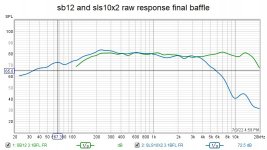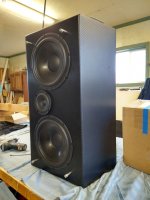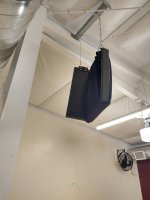Most full range speakers are 8 in and larger. I'm planning to build an open baffle speaker with an included woofer. I'd like to use the Visaton B100 4 inch as the full range speaker. I was looking at the Visaton B200 8 inch first and noticed how much better the polar dispersion is in the B100. It seems to me that a four inch speaker would be faster and better localization too; but at a reduced volume.
Why not?
I'm planning to crossover to the woofer at 100-200 Hz to relieve the 4 inch of bass duty. Shouldn't that get me to a 90db output level? I don't need a lot of volume preferring smaller ensemble music -- and I have a JBL horn system in another room.
So right now I'm planning to build the Visaton No Box speaker about 25% smaller in height and width but not depth. I think I'd also offset the 4" somewhat to the outer edges of the pair. I'd use an electronic crossover and separate class D amplification for the woofers- Eminence Alpha 12a's.
Am I missing anything here???
Thanks for any help


Why not?
I'm planning to crossover to the woofer at 100-200 Hz to relieve the 4 inch of bass duty. Shouldn't that get me to a 90db output level? I don't need a lot of volume preferring smaller ensemble music -- and I have a JBL horn system in another room.
So right now I'm planning to build the Visaton No Box speaker about 25% smaller in height and width but not depth. I think I'd also offset the 4" somewhat to the outer edges of the pair. I'd use an electronic crossover and separate class D amplification for the woofers- Eminence Alpha 12a's.
Am I missing anything here???
Thanks for any help
Making baffle smaller will result is less bass due to cancellation. If you do not require loud bass, you may be ok. You may need l-pad on fullrange to match sensitivity. If you are going active crossover, no need. Its common to cross woofer lower to shape the response. While maintaining the crossover for fullrange. Just like Mr. Nelson is doing. Or in case of Manzanita speakers.
I think it is a good idea to use a smaller fullrange if you have a woofer for bass anyway. I can't say if reduced baffle size and your woofer will produce enough bass.
Most full range speakers are 8 in and larger.
A quite false statement. Not even close. Most FR speakers are smaller than 8”.
Probably the greatest population of FR speakers are in phones.
dave
Go read Martin King’s seminal OB paper. Particularily the XO bit.
B200 REALLY needs a phas eplug to sort itd HF/dispersion issues, and is one of the few FRs that will produce bass on an OB.
If you are going to use B200 as bass, why not fix the driver and run it all the way up (menaung the B100 can stay in their box).
DO note the comment about bass & baffle size.
dave
B200 REALLY needs a phas eplug to sort itd HF/dispersion issues, and is one of the few FRs that will produce bass on an OB.
If you are going to use B200 as bass, why not fix the driver and run it all the way up (menaung the B100 can stay in their box).
DO note the comment about bass & baffle size.
dave
Just in case the OP wants to read Martin's papers: http://www.quarter-wave.com/OBs/OB_Theory.html
jeff
jeff
I'm planning to crossover to the woofer at 100-200 Hz to relieve the 4 inch of bass duty. Shouldn't that get me to a 90db output level?
With OB power output capacity bass is the challenge, due to the usual bass power needs compounded by dipole cancellation at longer wavelengths - so double trouble. The dB as the listening position will depend on the speaker capacity, the room and distance. You might find youre in trouble with your current plan.
I don't need a lot of volume preferring smaller ensemble music -- and I have a JBL horn system in another room. I'd use an electronic crossover and separate class D amplification for the woofers- Eminence Alpha 12a's.
Am I missing anything here???
Thanks for any help
Have you done sims? If the mid output is much higher than the woofer the sound can be expected to be thin and lacking, even with baroque ensembles at only moderate volumes.
The Alpha can be expected to be anaemic with the miniature Xmax and only 12":
The 12A doesn't look suited for OB with sims showing it to be dB limited by its Xmax under 140Hz with a 25dB drop off at 60Hz. Maybe if you only listen quietly at less then 70dB it will be OK but if anyone else turns up the volume Xdamage at ± 6.6 at full power sims at only 100Hz and below.
Try modelling a woofer designed for OB use eg an AE Dipole 15" or 18"
Wow. Thank you all. I am planning to use an active crossover and amplifier for the bass which I think should help.
As a result of the comments I've looked around a bit more and think the Eminence Delta Pro 12 should be able to deal with more power and more mids if needed. Its also much more efficient. I was trying to keep the Qts high for the woofer but I've been reading this morning that lower Qts is fine if just handling bass. I do like detail and control in my music and its why I'm trying to keep the drivers smaller.
And I actually did read the Martin paper, but I thought the passive crossover was a bit of a different beast.
I'll try to keep the baffle as large as the wife can tolerate 🙂
As a result of the comments I've looked around a bit more and think the Eminence Delta Pro 12 should be able to deal with more power and more mids if needed. Its also much more efficient. I was trying to keep the Qts high for the woofer but I've been reading this morning that lower Qts is fine if just handling bass. I do like detail and control in my music and its why I'm trying to keep the drivers smaller.
And I actually did read the Martin paper, but I thought the passive crossover was a bit of a different beast.
I'll try to keep the baffle as large as the wife can tolerate 🙂
You'll need ~24 inches worth of separation between front and rear waves of that 4 inch driver to support it down to 200hz and see 90db, with at least 14 inches of that being the front baffle or it will start to roll off too soon to get there. A 300hz crossover target may be more realistic, and sound more realistic in terms of energy in that region too. A driver offset from center and asymmetric length wings can help smooth the frequency response in a build like that. A couple of good 10 inch drivers run in parallel is another option to consider and will allow you to experiment with even higher crossover points.
As an example, here is a 4" sb mid used as a full range with two peerless 10 inch drivers run in parallel. The face of the baffle is a bit over 14" wide, around 28 inches tall and the longer wing is 10.5" at around a 12 degree angle, while the shorter wing with no angle is a little over 3" if I remember correctly.
I had to build a couple extra baffles before I determined the response was better without the full range countersunk. The full range is also offset to the short side. All the fiddling and rebuilding was worth it, as it smoothed the dipole response considerably and the sensitivity of the parallel tens matched the 90db sensitivity of the full range nicely. One of the best raw measurements I've seen of a dipole.
As you can see, the rolloff begins around 200hz. The nice thing is, the sb 4" can play considerably louder above this point on an open baffle compared to in a monopole. The crossover was placed at 400hz 24db/oct LR. Unfortunately I cannot find the final measurements I took in the studio at the moment. There are also 2 x 12" subs on the floor that come in at 80hz.
I used a dipole MTM to prevent feedback into the instructor's microphone, and keep the instructor and members under the speakers from getting blasted, while those further away got plenty of SPL. These things have been cranked on a daily basis for over half a year now and no problems whatsoever.
You can do it, just giving you the practical reality. They throw a huge image and are very sensitive, I liked them very much.
I had to build a couple extra baffles before I determined the response was better without the full range countersunk. The full range is also offset to the short side. All the fiddling and rebuilding was worth it, as it smoothed the dipole response considerably and the sensitivity of the parallel tens matched the 90db sensitivity of the full range nicely. One of the best raw measurements I've seen of a dipole.
As you can see, the rolloff begins around 200hz. The nice thing is, the sb 4" can play considerably louder above this point on an open baffle compared to in a monopole. The crossover was placed at 400hz 24db/oct LR. Unfortunately I cannot find the final measurements I took in the studio at the moment. There are also 2 x 12" subs on the floor that come in at 80hz.
I used a dipole MTM to prevent feedback into the instructor's microphone, and keep the instructor and members under the speakers from getting blasted, while those further away got plenty of SPL. These things have been cranked on a daily basis for over half a year now and no problems whatsoever.
You can do it, just giving you the practical reality. They throw a huge image and are very sensitive, I liked them very much.
Attachments
sb 4" can play considerably louder above this point on an open baffle compared to in a monopole
That's a very smart dipole design. Im not sure why a 4" would do higher SPL in a dipole then monopoles above cancellation. Is it just the rear radiation indirect sound effect maybe?
Appreciate that Kazap. You're correct; once you get above the point where a monopole and dipole are capable of the same spl on a given size baffle, which Linkwitz referred to as F equal, then the rear radiation becomes an additional source.
Monopole spl capability would rise with baffle step in the forward direction as it transitioned into half space radiation and became directional at higher frequencies. Dipole does the same thing but it also does it to the rear, adding to the overall spl capability of the driver in that region.
Monopole spl capability would rise with baffle step in the forward direction as it transitioned into half space radiation and became directional at higher frequencies. Dipole does the same thing but it also does it to the rear, adding to the overall spl capability of the driver in that region.
Thank you grangerm. A handy tool to determine driver capability on a given size baffle is Linkwitz's spl_max1.xls spreadsheet. Enter the driver Sd, it's one way Xmax (not point to point) and for path distance D use the center of the driver to edge of baffle on one side. The driver will get additional 6db of capability at the crossover point to the woofer. You'll find it about half way down the Linkwitzlab page index. You can use a smaller baffle, but you will have to low shelf the full range to make the crossover point as it will be rolling off earlier. You're welcome, good luck and enjoy experimenting and listening! (So much easier with DSP nowadays than when I started building speakers.)
Alright, I got some measurements from the spin studio, and as you can see it wasn't easy.

Note the sub on the floor underneath my "bucket mic stand base". The knee wall is about 3.5 ft high, and does give the sub enough bottom lift that I have to turn it down compared to the one on the other side of the room. They're Dayton sub 1200s, used basically because they're so damn cheap and get the job done. I've also learned that putting the subs on either side of the instructor keeps them from turning the system up too damn loud and blasting members on the far side of the room.
Measurements of the front and rear as best I could below. These are ungated 500ms measurements with plenty of reflections, 1/3 octave smoothed. Despite bouncing off so many things and the distance to the sub, they aren't bad at all. I routed a roundover on to the back of the fullrange through hole, but you can still see some lift around 1200hz before the top end starts to roll off in the rear. The mic distances could not be measured perfectly, but I tried to keep them close to 1 meter.

Note the sub on the floor underneath my "bucket mic stand base". The knee wall is about 3.5 ft high, and does give the sub enough bottom lift that I have to turn it down compared to the one on the other side of the room. They're Dayton sub 1200s, used basically because they're so damn cheap and get the job done. I've also learned that putting the subs on either side of the instructor keeps them from turning the system up too damn loud and blasting members on the far side of the room.
Measurements of the front and rear as best I could below. These are ungated 500ms measurements with plenty of reflections, 1/3 octave smoothed. Despite bouncing off so many things and the distance to the sub, they aren't bad at all. I routed a roundover on to the back of the fullrange through hole, but you can still see some lift around 1200hz before the top end starts to roll off in the rear. The mic distances could not be measured perfectly, but I tried to keep them close to 1 meter.
It it wasn't mentioned already I'd take a look at the "SLOB" (slot loaded open baffle) design.
DIYAudio SLOB thread and Speaker Camp 2022
It seems pretty well thought out and has a smaller baffle with a down firing bass driver.
edit: well, "small baffle" is arguable 😛
DIYAudio SLOB thread and Speaker Camp 2022
It seems pretty well thought out and has a smaller baffle with a down firing bass driver.
edit: well, "small baffle" is arguable 😛
Last edited:
If you want a mid size full range speaker on OB, you should do some reading in this thread.
https://www.diyaudio.com/community/threads/fast-fun-inexpensive-ob-project.110583/latest
Look more toward the end, as that’s close to what you want. The principles used in the Manzanita project apply closely to what you are doing.
https://www.diyaudio.com/community/threads/fast-fun-inexpensive-ob-project.110583/latest
Look more toward the end, as that’s close to what you want. The principles used in the Manzanita project apply closely to what you are doing.
- Home
- Loudspeakers
- Full Range
- Full Range Speaker Size in Open Baffle



